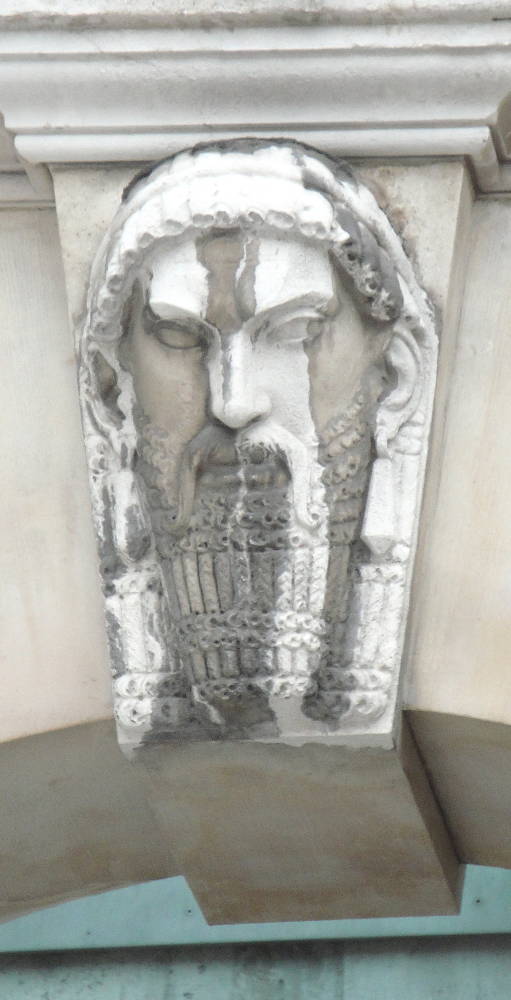
"The Veil of Time," keystone on the façade of the Society of Antiquaries building, above the entrance. The Society of Antiquaries, Burlington House, Piccadilly, London. Architects of the forecourt buildings: R. R. Banks and Charles Barry, Jnr. 1868-73. The society's first meeting was held here in January 1875. [Click on this and the following mages to enlarge them.]



Left: Closer view of "The Veil of Time." Right (for comparison): Two keystones over the portico of the Royal Academy, one with an Assyrian head (far left of the portico), and the other looking like Father Thames (towards the right of the portico).
The Society of Antiquaries was founded in 1707, and received its Royal Charter, charging it with "the encouragement, advancement and furtherance of the study and knowledge of the antiquities and history of this and other cultures," in 1751 ("About the Society of Antiquaries"). Prominent Victorian members include the artist Samuel Prout (1783-1852), the archaeologist Sir John Evans (1823-1908), who was President of the Society from 1885-92, and William Morris (1834-1896), whose former home, Kelmscott Manor in Gloucestershire, is managed by the society even now.
The Society moved to its Piccadilly premises from Somerset House in 1875, after Banks and Barry had remodelled the forecourt buildings of Burlington House to accommodate this and other learned institutions. "The architects were required to consult with Sydney Smirke [who was to add a second storey to the Royal Academy building at the back of the forecourt] to secure 'harmony of design' in the work to be executed for the societies and the academy" (Sheppard). The resultant "heavy Italianate blocks" (Weinreb et al. 116) have been nicely relieved by vermiculation, rustication and keystone sculpture, as well as the iron lamp standards shown here, the gilded lettering over the entrances, the upper storey balustrade etc. The keystones on the learned societies complement those on the façade of the Royal Academy, which were inspired by the keystones of Somerset House (see Schmidt 16).
Photographs by George P. Landow. Commentary by Jacqueline Banerjee, with many thanks to Julia Dudkiewicz, Collections Manager of the Society of Antiquaries, for her help. [You may use these images without prior permission for any scholarly or educational purpose as long as you (1) credit the photographers and (2) link your document to this URL in a web document or cite the Victorian Web in a print one.]
Other Views and Related Material
- Detail: statues along the upper storey of the Royal Academy
- Statue of Sir Joshua Reynolds in forecourt
- Burlington House, Piccadilly façade with arched entrance to the RA forecourt
- Painting, Antiquarian Knowledge, and other allegorical figures on archway to Piccadilly
- 6, Burlington Gardens at the back of the RA, now a part of it
- The Society of Antiquaries (essay)
- Architectural Historians and Theorists (essay)
Sources
"The Apartments of The Society of Antiquaries, Burlington House, London W1." (see 19-24 for more about Banks and Barry and the architecture of both the exteriorand interior of the apartments.) The Society of Antiquaries. Web. 20 July 2012.
"About the Society of Antiquaries." The Society of Antiquaries. Web. 20 July 2012.
"Making History: Antiquaries in Britian". Yale Center for British Art. Web. 20 July 2012.
Schmidt, Peter, with Owen Hopkins. "Burlington House: A Brief History." Royal Academy of Arts. Web. 20 July 2012.
Sheppard, F. H. W. (Gen. Ed), "Burlington House." Survey of England, Vols. 31 and 32: St James, Westminster, Part 2 (1983): 390-429. Web. 20 July 2012.
Weinreb, Ben, et al, eds. The London Encyclopaedia. 3rd ed. London: Macmillan, 2008. Print.
Last modified 20 July 2012